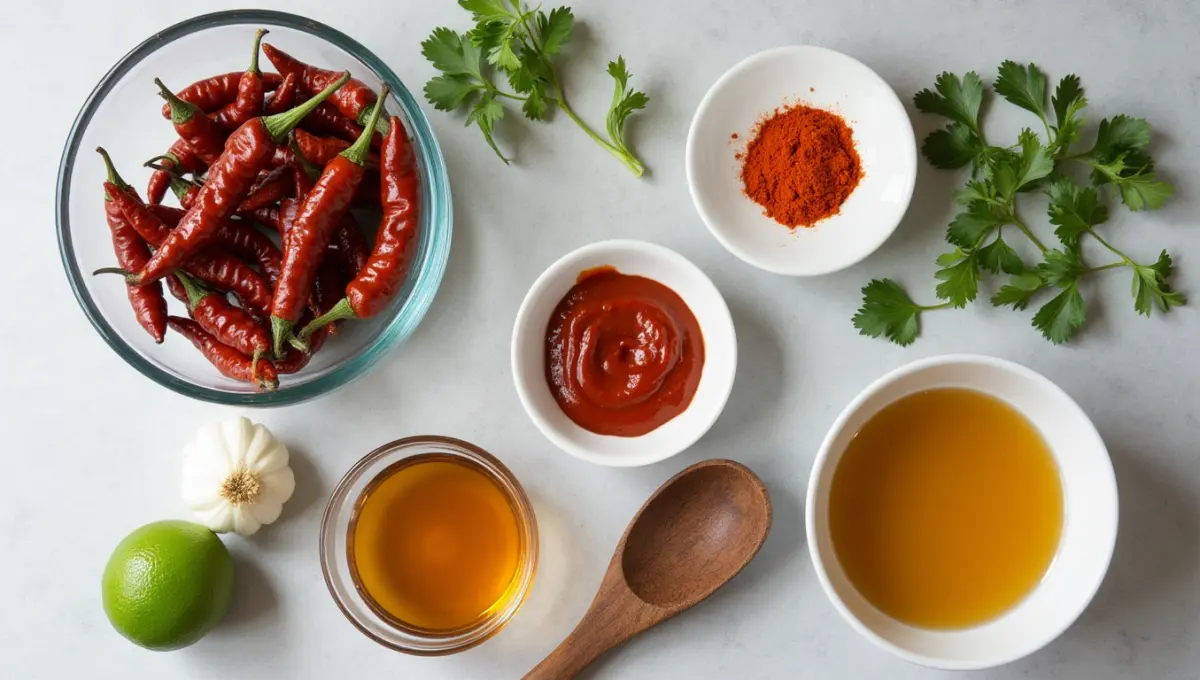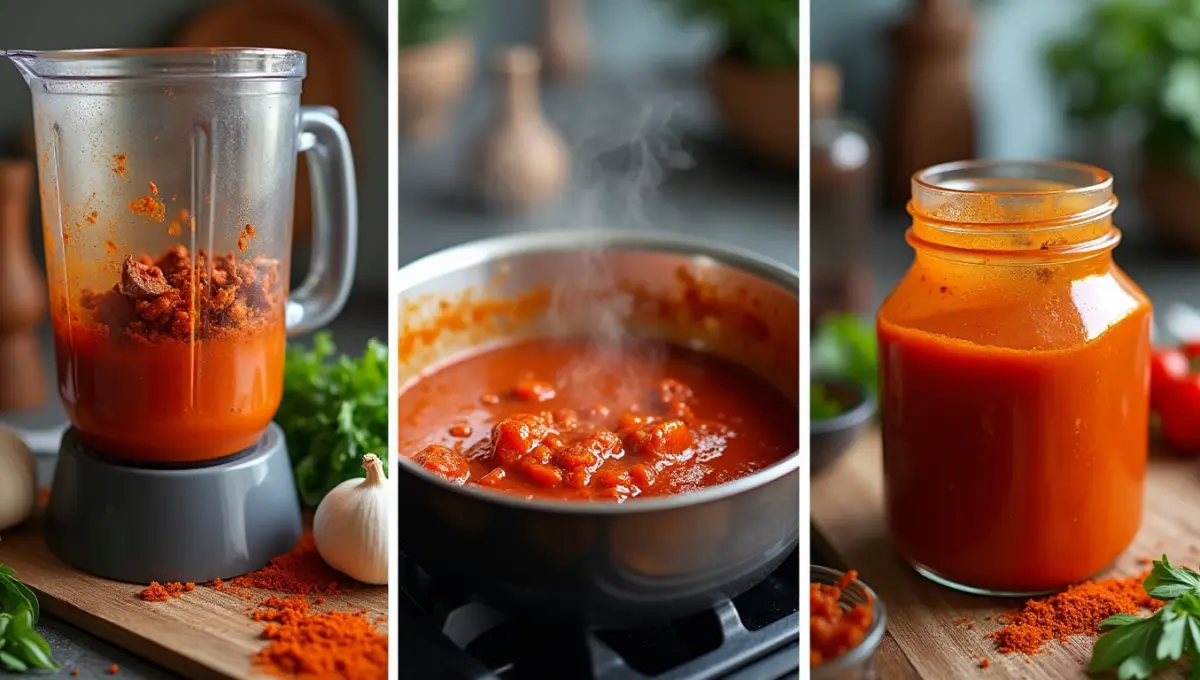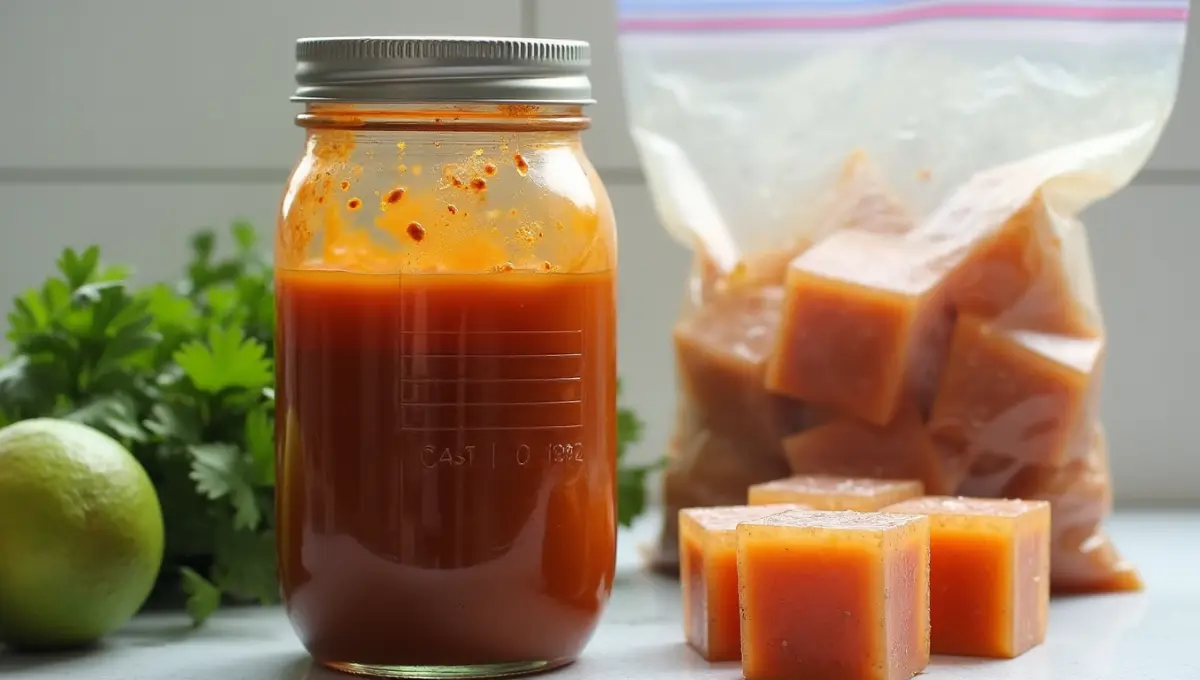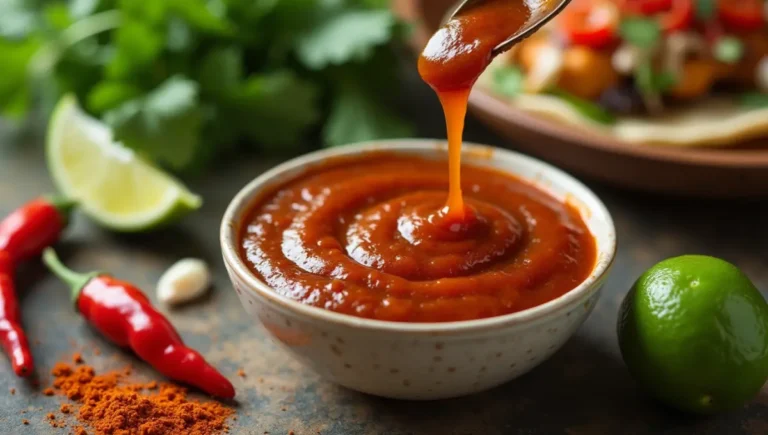Table of Contents
ToggleIf you’re looking for a bold, smoky, and versatile sauce to elevate your plant-based meals, this adobo sauce recipe is a must-try! Traditionally used in Mexican and Filipino cuisine, adobo sauce is known for its deep, tangy, and slightly spicy flavor. This homemade adobo sauce is completely plant-based, using wholesome ingredients like chipotle peppers, smoked paprika, garlic, and vinegar to create a rich and flavorful twist.
Whether you’re using it as a marinade, a dipping sauce, or a base for soups and stews, this vegan adobo sauce is incredibly easy to make with just a few pantry staples. If you love flavorful sauces, be sure to check out our Top 7 Plant-Based Sauces for Chicken Dishes for even more delicious options. Plus, with only three simple steps, you’ll have a delicious homemade sauce ready to enhance your favorite dishes. Let’s dive into how you can make this easy adobo sauce recipe at home!
What is Adobo Sauce? A Plant-Based Take
1. Origins of Adobo Sauce in Mexican and Filipino Cuisine
Adobo sauce has deep roots in both Mexican and Filipino cuisine, though the two versions have distinct characteristics. In Mexican cuisine, adobo sauce dates back to the Spanish colonization era when indigenous people combined native chili peppers with European spices to create a rich, flavorful sauce. This smoky and tangy sauce is commonly used to marinate meats, season stews, and add depth to dishes like enchiladas, tacos, and tamales.
On the other hand, Filipino adobo is quite different—it refers to a cooking method rather than a sauce. It involves braising proteins like chicken or pork in a mixture of vinegar, soy sauce, garlic, and spices. While Filipino adobo relies on liquid-based seasoning rather than a thick sauce, both culinary traditions share a love for bold, tangy, and umami-rich flavors.
2. How Traditional Adobo Sauce is Made
A classic adobo sauce recipe typically includes:
- Chipotle peppers or dried ancho chiles – For smoky heat and deep red color.
- Vinegar – Adds tanginess that enhances the overall flavor.
- Garlic and onion – Essential aromatics for a rich taste.
- Tomato paste or tomatoes – Helps thicken the sauce and adds natural sweetness.
- Spices like cumin, oregano, and smoked paprika – Bring warmth and complexity.
These ingredients are blended and simmered until thick, creating a deeply flavorful sauce that is often used to marinate meats or as a base for various dishes. However, traditional adobo sauce may contain animal-based ingredients like lard or beef broth, which makes it unsuitable for a plant-based diet.
3. Key Differences in a Plant-Based Version
A vegan adobo sauce recipe keeps all the bold, smoky, and tangy flavors but eliminates animal-based ingredients. Here’s how a plant-based adobo sauce differs:
- No lard or beef broth – Instead, plant-based fats like olive oil enhance richness.
- Natural sweetness alternatives – Instead of honey, we use maple syrup or agave nectar for balance.
- More emphasis on spices and umami-rich ingredients – Using smoked paprika, chipotle, and tomato paste helps replicate the depth of traditional adobo without meat-based components.
This homemade adobo sauce recipe is not only easy to make but also healthier, dairy-free, and perfect for enhancing plant-based dishes. Whether you use it to season tofu, jackfruit, or roasted vegetables, it delivers the same bold flavors without any compromise!
Ingredients

A great adobo sauce recipe is all about balancing smoky, tangy, spicy, and slightly sweet flavors. This plant-based version uses simple yet powerful ingredients to create a rich, flavorful sauce that enhances a variety of dishes. Below are the key ingredients that make this vegan adobo sauce both authentic and delicious.
- Chipotle Peppers & Smoked Paprika – For Deep, Smoky Heat
At the heart of any adobo sauce recipe is the deep, smoky heat that gives it its signature flavor. Chipotle peppers in adobo or dried chipotle peppers are commonly used to add a robust smokiness and a touch of heat. These smoked, dried jalapeños provide an earthy depth that pairs well with plant-based dishes.
To further enhance the smokiness, smoked paprika is a key addition. Unlike regular paprika, smoked paprika is made from pimiento peppers that have been dried and smoked over wood, infusing the sauce with a deep, rich aroma. This combination of chipotle and smoked paprika ensures that your vegan adobo sauce maintains the authentic, bold flavors found in traditional recipes.
- Garlic, Onion, and Spices (Cumin, Oregano, Salt) – For Rich Seasoning
A well-balanced adobo sauce recipe isn’t complete without aromatic seasonings. Garlic and onion serve as the foundation, providing depth and umami. These ingredients are often sautéed before blending to enhance their natural sweetness and robustness.
Additionally, spices like cumin, oregano, and salt play an essential role:- Cumin – Adds a warm, earthy note that complements the smokiness.
- Oregano – A-eyed-in Mexican cuisine, offering a slightly citrusy and peppery flavor.
- Salt – Enhances all the other flavors, ensuring a well-rounded taste.
This combination of garlic, onion, and spices creates a bold and well-seasoned adobo sauce that pairs perfectly with plant-based meals.
- Vinegar & Lime Juice – Adds Tang and Balances the Flavors
A key characteristic of an adobo sauce recipe is its tangy flavor, which comes from the addition of vinegar and lime juice. These ingredients help balance the heat and smokiness while adding a slight acidity that enhances the overall taste.- Vinegar – Traditionally, white vinegar or apple cider vinegar is used to provide a sharp, tangy contrast to the richness of the sauce.
- Lime Juice – Fresh lime juice adds brightness and a subtle citrusy note, making the flavors more vibrant.
This acidity is crucial in vegan adobo sauce, as it helps cut through the bold spices and brings out the depth of the ingredients.
- Tomato Paste & Maple Syrup – For Depth and a Hint of Sweetness
To round out the flavors, a balance of sweetness and umami is needed. This is achieved through tomato paste and maple syrup:- Tomato Paste – Provides a rich, umami-packed base that thickens the sauce and enhances its complexity. It also helps blend all the ingredients smoothly.
- Maple Syrup – Instead of honey or refined sugar, maple syrup adds a subtle sweetness that balances the acidity and spice without overpowering the sauce.
This perfect combination of smoky, tangy, and sweet flavors makes this vegan adobo sauce recipe a must-have for adding depth to any plant-based dish. Whether you’re using it as a marinade, dip, or sauce for tacos and burritos, these carefully selected ingredients ensure an authentic and delicious experience!
Instructions

Making a homemade adobo sauce recipe is incredibly simple and requires just three basic steps: blending, simmering, and storing. With this easy plant-based adobo sauce, you’ll have a rich, smoky, and tangy condiment ready to enhance your favorite dishes. Let’s break down each step in detail.
- Blend the Ingredients – Create a Smooth Consistency
The first step in this adobo sauce recipe is blending the ingredients to create a smooth, flavorful base. In a high-speed blender or food processor, combine the following:- Chipotle peppers in adobo (or dried chipotle, rehydrated) – For a smoky kick.
- Tomato paste – Adds thickness and a deep umami flavor.
- Garlic and onion – Essential aromatics that enhance depth.
- Smoked paprika, cumin, and oregano – Bring warmth and complexity.
- Vinegar and lime juice – Add a necessary tangy contrast.
- Maple syrup – Balances the heat and acidity with subtle sweetness.
- A splash of water or vegetable broth – Helps achieve the perfect consistency.
Blend everything until smooth, ensuring there are no chunks of pepper or spices left. If needed, add a bit more liquid to reach your desired thickness. This step ensures that your vegan adobo sauce has a velvety texture that coats ingredients beautifully.
- Simmer for Depth – Enhance the Flavors
Once the ingredients are blended into a smooth paste, it’s time to simmer the adobo sauce to develop its rich, bold flavors.- Pour the blended mixture into a saucepan over medium heat.
- Bring it to a gentle simmer, stirring occasionally to prevent sticking.
- Let it cook for about 10-15 minutes until the sauce thickens slightly and the flavors meld together.
Simmering is a crucial step in any adobo sauce recipe, as it allows the spices to infuse, the acidity to mellow out, and the smokiness to deepen. If the sauce becomes too thick, you can add a little more water or vegetable broth to loosen it up.
- Store & Use – Keep it Fresh for Future Recipes
After simmering, remove the vegan adobo sauce from the heat and let it cool completely. Once cooled, transfer it to an airtight glass jar or container and store it in the refrigerator.- Refrigeration: Keeps well for up to one week in the fridge.
- Freezing option: Pour into an ice cube tray and freeze for easy portioning.
- Reheating: Simply warm it up in a saucepan or microwave before using.
Now, your homemade adobo sauce recipe is ready to use! Drizzle it over tacos, mix it into marinades, or stir it into soups and stews for a burst of smoky, tangy goodness. This easy plant-based adobo sauce will quickly become a staple in your kitchen!
How to Use Adobo Sauce in Plant-Based Meals

Once you’ve made this delicious adobo sauce recipe, you’ll find countless ways to incorporate it into your plant-based meals. Its smoky, tangy, and slightly spicy flavor makes it a versatile addition to everything from marinades to dips and hearty stews. Here are some of the best ways to use homemade vegan adobo sauce in your everyday cooking.
1. As a Marinade – Perfect for Tofu, Tempeh, or Jackfruit
One of the best ways to use this adobo sauce recipe is as a marinade for plant-based proteins. The bold flavors of chipotle, smoked paprika, and vinegar help infuse tofu, tempeh, and jackfruit with deep, smoky richness.
- Tofu: Press and cube tofu, then coat it in adobo sauce before baking or pan-frying.
- Tempeh: Steam tempeh first to remove bitterness, then marinate it for at least 30 minutes before grilling.
- Jackfruit: Shred young jackfruit and let it soak in the sauce for an hour before sautéing for a pulled “pork” alternative.
For a delicious way to enjoy marinated plant-based proteins, try adding them to this Irresistible Burger Bowl Recipe. Marinating these ingredients in vegan adobo sauce adds depth, umami, and spice, making them perfect for tacos, grain bowls, or sandwiches.
2. In Tacos and Burritos – Adds Smoky Heat to Plant-Based Fillings
No taco night is complete without a bold, flavorful sauce! This adobo sauce recipe works beautifully as a seasoning for plant-based taco and burrito fillings.
- Sautéed mushrooms: Toss mushrooms in adobo sauce for a meaty, umami-packed taco filling.
- Lentil or walnut taco meat: Mix adobo sauce with cooked lentils or crushed walnuts for a hearty, protein-rich alternative.
- Roasted sweet potatoes: Coat diced sweet potatoes in the sauce before roasting for a smoky-sweet taco addition.
If you’re looking for a satisfying taco-inspired meal, check out this Stuffed Peppers with Beans and Rice recipe, where you can easily incorporate the smoky heat of adobo sauce into the filling.
3. As a Dipping Sauce – Pairs Well with Roasted Veggies or Fries
This adobo sauce recipe isn’t just for cooking—it makes a fantastic dipping sauce as well! Its rich, tangy-spicy profile pairs beautifully with crispy, roasted foods.
- Roasted cauliflower or Brussels sprouts: Toss in a little sauce before serving for an extra burst of flavor.
- Baked fries or sweet potato fries: Use adobo sauce as a bold dipping alternative to ketchup. Try it with this Loaded Fries Recipe for a next-level plant-based snack.
- Grilled corn or zucchini: Brush on before serving to enhance smokiness.
For a creamier version, mix adobo sauce with vegan mayo or cashew cream to create a spicy, smoky aioli perfect for dipping.
4. Mixed into Soups and Stews – Enhances Depth and Spice
A spoonful of adobo sauce can transform a simple soup or stew into a deeply flavorful dish. The combination of smoky chipotle, tangy vinegar, and warm spices adds depth and heat to plant-based broths.
- Vegan chili: Stir in a tablespoon of adobo sauce for a smoky, spicy kick.
- Black bean soup: Add a spoonful for extra richness and complexity.
- Lentil stew: Mix it in while simmering to enhance the earthy flavor of lentils.
For an ultra-comforting meal, try incorporating adobo sauce into this Swamp Soup Recipe for an extra smoky, spicy depth that takes the flavors to the next level.
Whether you’re marinating tofu, spicing up tacos, or mixing it into soups, this vegan adobo sauce is a must-have for plant-based cooking. Its smoky, tangy, and slightly sweet flavor makes every dish more exciting. Try experimenting with different ways to use it, and enjoy a versatile, homemade adobo sauce that enhances every meal!
Storing and Customizing Your Adobo Sauce

Once you’ve prepared your adobo sauce recipe, proper storage ensures that you can enjoy its smoky, tangy goodness for future meals. Additionally, this versatile sauce can be easily customized to match your preferred level of heat, sweetness, and tanginess. Below, we’ll explore the best ways to store your homemade adobo sauce and how to tweak it to suit your taste.
1. Storage Tips: Keep in an Airtight Jar in the Fridge for Up to a Week
To maintain freshness and flavor, store your vegan adobo sauce in an airtight glass jar or container. This helps prevent oxidation and preserves the bold, smoky taste.
- Refrigeration: Your adobo sauce recipe will stay fresh in the refrigerator for up to one week when stored properly.
- Stir before use: The sauce may thicken slightly as it sits, so give it a quick stir before using.
- Use clean utensils: Always use a clean spoon to avoid contamination, which can extend shelf life.
If you plan to use adobo sauce regularly, consider making a larger batch and storing it in different-sized jars for easy access throughout the week. For meal prep ideas using flavorful sauces like this, check out these High-Protein Crockpot Recipes to keep your plant-based meals both convenient and nutritious.
2. Customization Ideas: Adjust Heat, Sweetness, or Tanginess to Taste
One of the best things about a homemade adobo sauce recipe is that you can adjust it to fit your personal flavor preferences. Here are some simple ways to customize your sauce:
- To increase heat: Add more chipotle peppers, a dash of cayenne pepper, or extra smoked paprika for a spicier kick.
- To make it milder: Reduce the number of chipotle peppers and add more tomato paste to mellow out the spice.
- For extra sweetness: If you prefer a sweeter sauce, add a bit more maple syrup, agave nectar, or a touch of coconut sugar.
- To enhance tanginess: Increase the vinegar or lime juice for a sharper, more vibrant flavor.
By tweaking these elements, you can create an adobo sauce recipe that perfectly complements your favorite plant-based dishes.
3. Freezing Option: Store in Ice Cube Trays for Easy Portioning
If you don’t plan to use all of your homemade adobo sauce within a week, freezing is a great option to extend its shelf life. The easiest way to do this is by freezing the sauce in ice cube trays:
- Pour the adobo sauce into an ice cube tray in small portions.
- Freeze until solid, then transfer the cubes to a sealed freezer bag or container.
- When needed, simply take out a cube or two and thaw in the refrigerator or microwave.
This method allows for easy portioning, so you can use just the right amount without thawing the entire batch. Frozen adobo sauce can last for up to three months, making it a convenient meal prep ingredient!
With proper storage and customization, this adobo sauce recipe becomes a flexible, long-lasting staple in your plant-based kitchen. Whether refrigerated for quick use or frozen for later, this smoky, tangy sauce is always ready to enhance your favorite dishes. Experiment with different flavors and spice levels to make it truly your own!
FAQs
1. Can I make adobo sauce without chipotle peppers?
Yes, you can substitute chipotle peppers with dried ancho chiles or guajillo chiles for a milder flavor. Rehydrate the dried chiles in hot water before blending, and consider adding a pinch of smoked paprika to maintain the smoky profile.
2. How long does homemade adobo sauce last?
When stored in an airtight container in the refrigerator, homemade vegan adobo sauce lasts up to one week. For longer storage, freeze it in ice cube trays for up to three months.
3. Is this adobo sauce very spicy?
The spice level depends on the amount of chipotle peppers used. For a milder sauce, reduce the number of chipotle peppers or balance the heat with extra tomato paste or maple syrup. Adjust to your taste!
4. Can I use adobo sauce in non-vegan dishes?
Absolutely! While this recipe is plant-based, the sauce is versatile and can be used in any dish, including non-vegan ones, as a marinade, dip, or flavor enhancer.
Conclusion
Creating your own adobo sauce recipe at home is not only easy but also incredibly rewarding. This plant-based adobo sauce is packed with bold, smoky flavors and can be used in a variety of dishes, from marinades to soups, tacos, and even dips. With just a few simple ingredients and three easy steps, you can make a homemade sauce that enhances your favorite plant-based meals with a rich, tangy, and slightly spicy kick.
The beauty of this vegan adobo sauce lies in its versatility. Whether you’re marinating tofu, drizzling it over burrito bowls, or stirring it into a hearty stew, this sauce can adapt to your culinary needs. Plus, with customization options, you can adjust the heat, sweetness, or tanginess to match your personal taste. And if you have leftovers, storing it in the fridge or freezing it in portions ensures that you always have a flavorful sauce ready to go.
To make this recipe even easier, consider using this high-powered blender to achieve the perfect smooth consistency for your adobo sauce. And if you’re looking for a set of glass storage jars to keep your sauce fresh, this airtight container set is a great option for long-lasting storage.
Now it’s your turn to try this adobo sauce recipe! Experiment with different ways to use it in your meals and see how it transforms your dishes with its bold flavors. We’d love to hear from you! Leave a comment below and let us know how you like to use adobo sauce in your plant-based cooking. And if you enjoyed this recipe, don’t forget to share it with fellow food lovers who are looking for delicious and easy ways to add flavor to their meals. Happy cooking!


6 thoughts on “Adobo Sauce Recipe: 3 Easy Steps to a Plant-Based Twist”